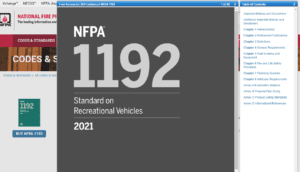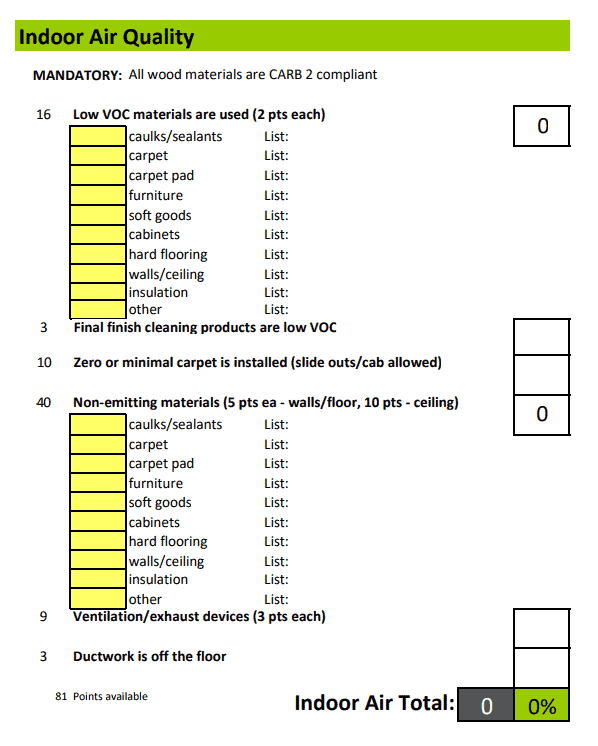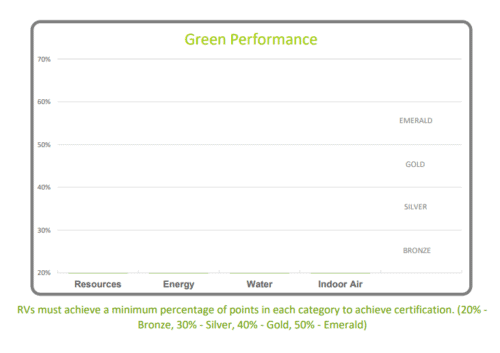Do you have lungs? Would you like to keep them? Good. (You and me both!)
Air is the one thing you can’t live without, and airborne pollutants are the ones you usually can’t see. So let’s chat about the indoor air quality of your camper.
I have good news and bad news.
The bad news is that RV indoor air quality is usually mediocre, there are no enforced codes or universal testing standards, very little OEM innovation, and DIY solutions are time-consuming.
The good news is I saved 15% or more on my car insurance.
>>> This is Part 1: An Overview of Your RV’s Indoor Air Quality.
Read the Rest of the Series!
Is the Air Inside an RV Safe to Breathe?
Let me sell it to you straight.
There is no industry requirement for measuring indoor air quality in an RV.
RV manufacturers who are part of RVIA, the Recreational Vehicle Industry Association, abide by several standards, such as NFPA 1192, Standard on Recreational Vehicles.
However, there is no air quality requirement in NFPA 1192 (2021 edition).

So if you ask an RV manufacturer, “What’s the air quality of your RV interior?” most won’t have the faintest clue.
And if two manufacturers do share ratings with you, there’s no guarantee you can compare the two. They may have different test bases!
What About Certified Green RVs and Campers?
There’s a new kid on the block called TRA from Green RVs. They have emerged as the leading independent certification body for “green” eco-friendly RVs.
Now, let me state for the record that I love this idea! And I highly recommend you take advantage of their awesome website here!
Unfortunately, TRA is still so new that many otherwise worthy manufacturers just aren’t participating yet.
Also, TRA looks at Resource Efficiency, Energy Efficiency, Water Efficiency & Indoor Air Quality.
You can check out their RV green certification rating checklist here.

I like a lot of what I’m seeing:
- Mandatory Carb II compliance for all wood products
- Low-VOC furniture and carpet
- Non-emitting insulation

However, the standards for excellence are fairly low. A company can achieve “Bronze” TRA Certification just by eliminating carpet, installing direct-vent ACs, choosing block foam insulation and installing extra roof vents – and that does not a chemical-safe RV make!
So it’s a step in the right direction. But as of now, green RV certification is in its infancy.
Of course, you may be wondering why people care about RV safe air quality in the first place?
Let’s hop in our wayback machine and return to the far, faraway land of 2008.
Short-Term Housing = Long-Term Problems
In 2008, hurricane Katrina dealt the U.S. a blow it wouldn’t soon forget.
Waves from the Gulf of Mexico up to 55 feet tall deluged the Deep South beaches.
New Orleans, the region’s urban crown jewel, was drowned in the surge. More than 1 million people were displaced.
FEMA supplied thousands of travel trailers, park models and mobile homes for these lost victims. For the first time since the disaster, they could finally breathe easy.
But for many, that didn’t last. Thousands complained of health issues like severe headaches, congestion, and trouble breathing. Some, particularly the young and elderly, wound up in the ER.

The Sierra Club gathered anecdotal evidence. The EPA waded in. Litigation began. What was happening to these people?
What they discovered was that almost nine out of 10 trailers had significant levels of formaldehyde, an airborne toxin and known carcinogen common in manufactured wood products. In many cases, the ppm concentrations were far in excess of the legal limit!
FEMA recommended, “Families who live in travel trailers and mobile homes should spend as much time outdoors in fresh air as possible. This is especially important for families with children, elderly people, or those with chronic diseases such as asthma.”
That’s some scary stuff! To be told you shouldn’t breathe the air in your own home.
The FEMA formaldehyde scare left a stain on the legacy of the RV industry.
And it begs the question: Are modern RVs any safer?
How Clean Is the Air Inside an RV?
Let’s define indoor air quality (IAQ).
No, we’re not talking about odor.
We’re talking about the impact of the air you breathe on your long-term health.
Indoor air quality is the conditioning and cleanliness of your air.
- Condition refers to temperature, humidity, oxygenation, etc.
- Cleanliness refers to chemical concentration, dust, allergens, mold, etc.
Air Conditioning
After COVID-19, most of us have started to care more about the quality of our air. We don’t want super dry air (below 30% humidity) that helps viruses live longer, irritates our sinuses, and makes our eyes itch. We also don’t want super humid air (above 60%) that leads to condensation and fosters mold. Part of healthy air is controlling the air temperature and relative humidity.
You can control the conditioning of your air the same you do your home:
- In the summer, run the air conditioner to cool and dehumidify your interior air. In very humid climates, you may need to supplement the air conditioner with a portable dehumidifier.
- In the winter, run your furnace to heat the air to avoid condensation on cold surfaces, and increase the humidity with a portable humidifier. You can control humidity and condensation in the winter with dehumidification tablets like DampRid.
Air Cleanliness
Air is made up of mostly five gases: nitrogen, oxygen, water vapor, argon, and carbon dioxide. But air is a carrier for other things: viruses, bacteria, dust, dander, pet hair, scents, VOCs, and a thousand other microscopic things.
In an RV, it’s hard to control the exchange of the interior air. They are just too small, too drafty. So it’s best to follow a few basic strategies:
- Clean out your A/C filters and furnace as often as the manufacturer requires! This is usually every 2 weeks for A/C filters and every year for furnace ductwork and blower.
- Use an interior air purifier at night and whenever the doors and windows are closed for an extended time.
- “Burn off” a new RV to accelerate the initial off-gassing of toxic VOCs.
- Keep your smoke alarm and CO detectors up to date!
- Don’t park too close to your neighbors. You might get wood smoke, generator exhaust fumes, and other unsavory gases into your camper.
Mugshots: Meet the Enemies of Clean Air
Now, we all want clean, pure, fresh air in our RVs and campers! Unfortunately, we wage war against three enemies:
We’ll talk more about these in greater depth in Parts 2, 3, and 4 of this series on RV indoor air quality. Thanks for reading!
Leave a Reply